lock YAMAHA SUPERJET 2019 Owners Manual
[x] Cancel search | Manufacturer: YAMAHA, Model Year: 2019, Model line: SUPERJET, Model: YAMAHA SUPERJET 2019Pages: 78, PDF Size: 2.75 MB
Page 15 of 78
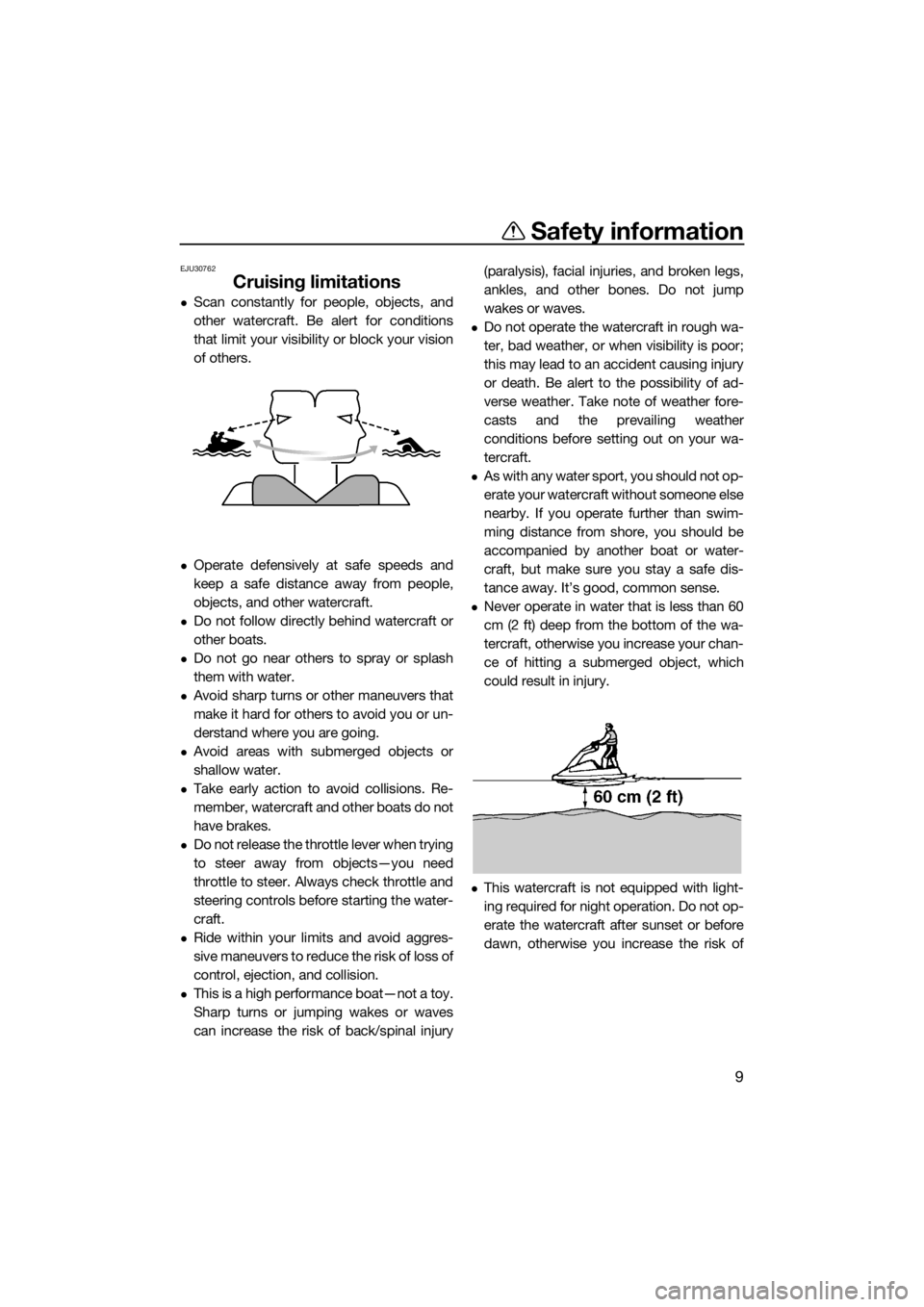
Safety information
9
EJU30762
Cruising limitations
Scan constantly for people, objects, and
other watercraft. Be alert for conditions
that limit your visibility or block your vision
of others.
Operate defensively at safe speeds and
keep a safe distance away from people,
objects, and other watercraft.
Do not follow directly behind watercraft or
other boats.
Do not go near others to spray or splash
them with water.
Avoid sharp turns or other maneuvers that
make it hard for others to avoid you or un-
derstand where you are going.
Avoid areas with submerged objects or
shallow water.
Take early action to avoid collisions. Re-
member, watercraft and other boats do not
have brakes.
Do not release the throttle lever when trying
to steer away from objects—you need
throttle to steer. Always check throttle and
steering controls before starting the water-
craft.
Ride within your limits and avoid aggres-
sive maneuvers to reduce the risk of loss of
control, ejection, and collision.
This is a high performance boat—not a toy.
Sharp turns or jumping wakes or waves
can increase the risk of back/spinal injury(paralysis), facial injuries, and broken legs,
ankles, and other bones. Do not jump
wakes or waves.
Do not operate the watercraft in rough wa-
ter, bad weather, or when visibility is poor;
this may lead to an accident causing injury
or death. Be alert to the possibility of ad-
verse weather. Take note of weather fore-
casts and the prevailing weather
conditions before setting out on your wa-
tercraft.
As with any water sport, you should not op-
erate your watercraft without someone else
nearby. If you operate further than swim-
ming distance from shore, you should be
accompanied by another boat or water-
craft, but make sure you stay a safe dis-
tance away. It’s good, common sense.
Never operate in water that is less than 60
cm (2 ft) deep from the bottom of the wa-
tercraft, otherwise you increase your chan-
ce of hitting a submerged object, which
could result in injury.
This watercraft is not equipped with light-
ing required for night operation. Do not op-
erate the watercraft after sunset or before
dawn, otherwise you increase the risk of
UF4D75E0.book Page 9 Monday, March 19, 2018 3:02 PM
Page 29 of 78
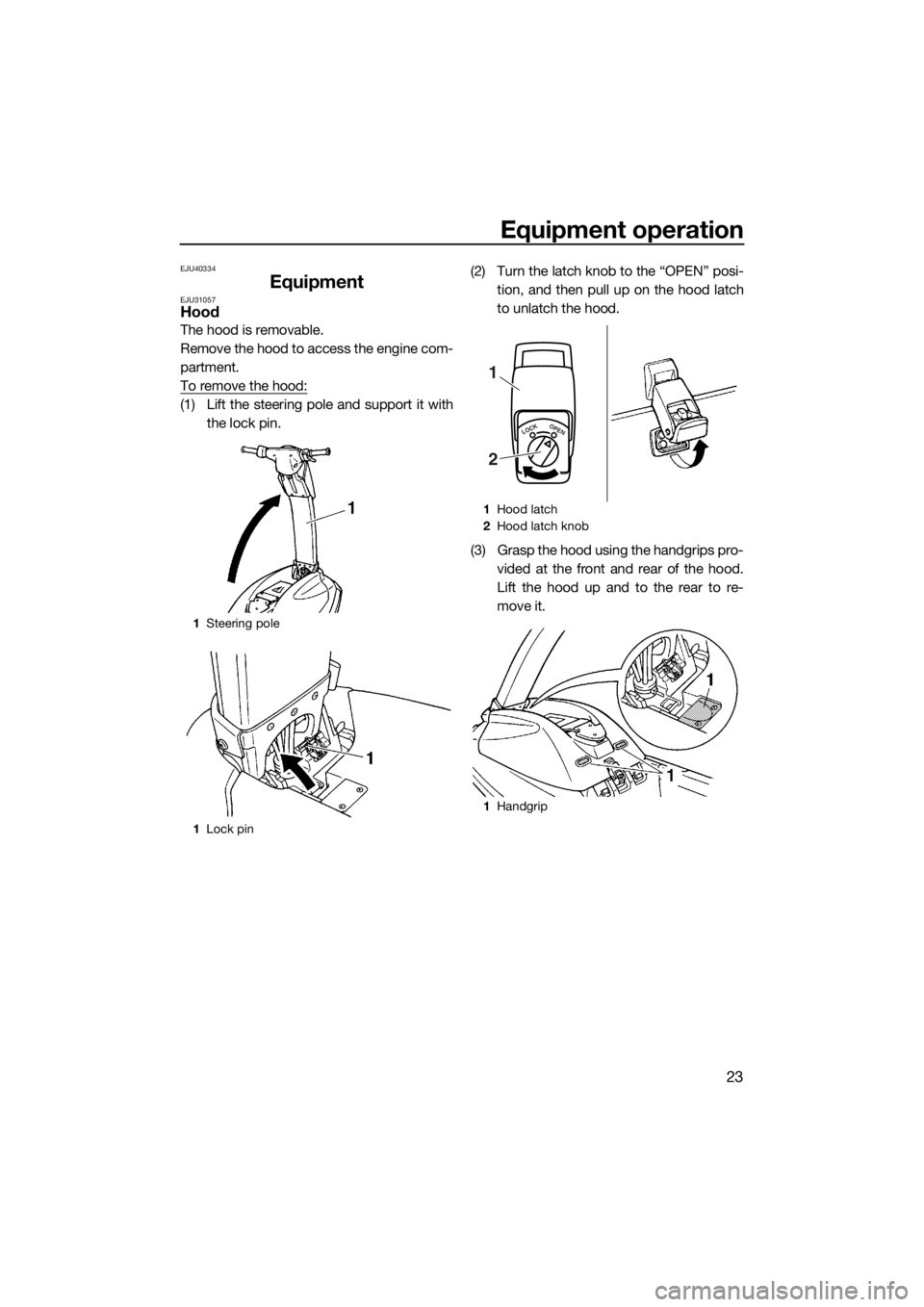
Equipment operation
23
EJU40334
EquipmentEJU31057Hood
The hood is removable.
Remove the hood to access the engine com-
partment.
To remove the hood:
(1) Lift the steering pole and support it with
the lock pin.(2) Turn the latch knob to the “OPEN” posi-
tion, and then pull up on the hood latch
to unlatch the hood.
(3) Grasp the hood using the handgrips pro-
vided at the front and rear of the hood.
Lift the hood up and to the rear to re-
move it.
1Steering pole
1Lock pin
1Hood latch
2Hood latch knob
1Handgrip
LOCKOPEN
1
2
UF4D75E0.book Page 23 Monday, March 19, 2018 3:02 PM
Page 30 of 78

Equipment operation
24
To install the hood:
(1) Position the hood on the deck so that the
two projections at the front of the hood fit
under the two stays on the deck.
(2) Push down on the hood latch, and then
turn the knob to the “LOCK” position to
securely lock the hood in place.
(3) While holding the steering pole, move
the lock pin to the stowed position, and
then lower the steering pole.
EJU36003Bow rope hole
The bow rope hole is used to attach a rope to
the watercraft when transporting, mooring, ortowing it in an emergency. (See page 68 for
information on towing the watercraft.)
EJU36012Stern rope hole
The stern rope hole is used to attach a rope
to the watercraft when mooring it.
EJU31676Storage pouch
The storage pouch is located on the bottom
of the hood.
Use the storage pouch to store the own-
er’s/operator’s manual, tool kit, and other
small items. The storage pouch is not de-
signed to be waterproof. If you carry objects
that must be kept dry, put them in a water-
proof bag.
To remove the storage pouch:
(1) Remove the hood. (See page 23 for hood
removal and installation procedures.)
LOCKOPEN
1Bow rope hole
1Stern rope hole
UF4D75E0.book Page 24 Monday, March 19, 2018 3:02 PM
Page 31 of 78
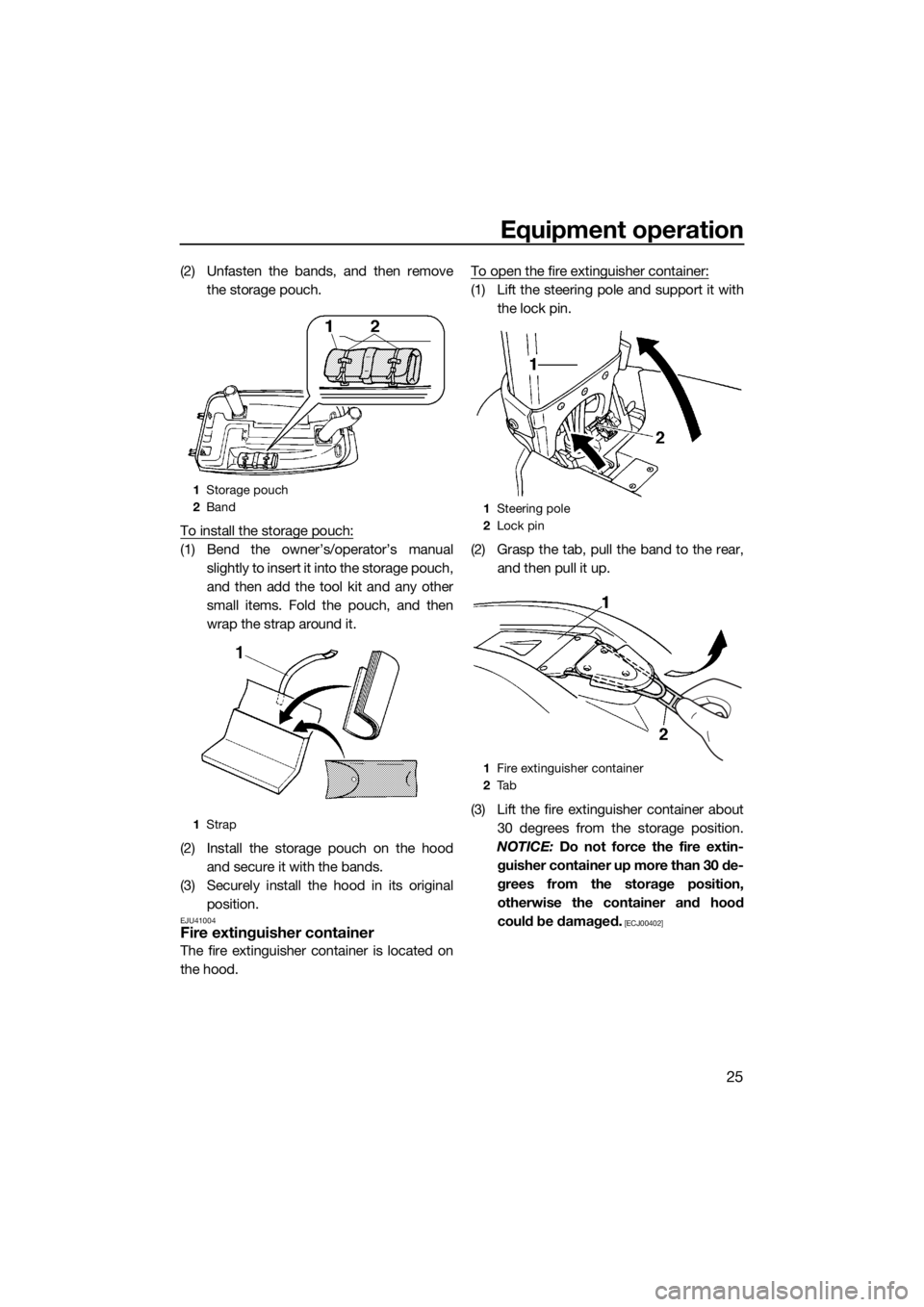
Equipment operation
25
(2) Unfasten the bands, and then remove
the storage pouch.
To install the storage pouch:
(1) Bend the owner’s/operator’s manual
slightly to insert it into the storage pouch,
and then add the tool kit and any other
small items. Fold the pouch, and then
wrap the strap around it.
(2) Install the storage pouch on the hood
and secure it with the bands.
(3) Securely install the hood in its original
position.
EJU41004Fire extinguisher container
The fire extinguisher container is located on
the hood.To open the fire extinguisher container:
(1) Lift the steering pole and support it with
the lock pin.
(2) Grasp the tab, pull the band to the rear,
and then pull it up.
(3) Lift the fire extinguisher container about
30 degrees from the storage position.
NOTICE: Do not force the fire extin-
guisher container up more than 30 de-
grees from the storage position,
otherwise the container and hood
could be damaged.
[ECJ00402]
1Storage pouch
2Band
1Strap
1Steering pole
2Lock pin
1Fire extinguisher container
2Ta b
UF4D75E0.book Page 25 Monday, March 19, 2018 3:02 PM
Page 32 of 78

Equipment operation
26
(4) Loosen the fire extinguisher container
cap and remove it.
To close the fire extinguisher container:
(1) Insert the fire extinguisher into the con-
tainer, and then securely install the fire
extinguisher container cap by tightening
it until it stops.
(2) Lower the container on the hood to its
storage position and secure it with the
band.
(3) While holding the steering pole, move
the lock pin to the stowed position, and
then lower the steering pole.
1Fire extinguisher container cap
UF4D75E0.book Page 26 Monday, March 19, 2018 3:02 PM
Page 46 of 78

Operation
40
EJU32903
Operating your watercraft
WARNING
EWJ00511
Before operating your watercraft, become
familiar with all of the controls. Consult a
Yamaha dealer about any control or func-
tion that you do not fully understand. Fail-
ure to understand how the controls work
could cause an accident or prevent you
from avoiding an accident.
EJU32924Getting to know your watercraft
Operating your watercraft requires skills ac-
quired through practice over a period of time.
Take the time to learn the basic techniques
well before attempting more difficult maneu-
vers.
Operating your new watercraft can be a very
enjoyable activity, providing you with hours of
pleasure. However, it is essential to familiar-
ize yourself with the operation of the water-
craft to achieve the skill level necessary to
enjoy riding safely.
Before operating this watercraft, read this
owner’s/operator’s manual, the Riding Prac-
tice Guide, the Riding Instruction card, and all
labels on the watercraft. Pay particular atten-
tion to the safety information beginning on
page 8. These materials should give you an
understanding of the watercraft and its oper-
ation.
Remember: This watercraft is designed to
carry the operator only. Never have more
than one person on the watercraft at any
time.
EJU32985Learning to operate your watercraft
Before operating the watercraft, always per-
form the pre-operation checks listed on page
33. The short time spent checking the water-craft will reward you with added safety and
reliability.
Check local laws before operating your wa-
tercraft.
Operate defensively at safe speeds and keep
a safe distance away from people, objects,
and other watercraft. Select a wide area to
practice maneuvering in, where there is good
visibility and light boat traffic.
Use the buddy system—operate with some-
one nearby. Scan constantly for people, ob-
jects, and other watercraft. Be alert for
conditions that limit your visibility or block
your vision of others.
You should grip the handlebars firmly and get
to a standing or kneeling position quickly.
Keep both feet or knees on the riding tray
when the watercraft is in motion.
EJU33172Operating positions
After you are underway, you may choose to
kneel or stand, depending upon watercraft
speed, your skill level, and your preference.
Here are some guidelines.
Kneeling
It is easier to maintain your balance when
kneeling than when standing. This position is
recommended when traveling at sub-planing
speeds. (At sub-planing speeds, there is a
UF4D75E0.book Page 40 Monday, March 19, 2018 3:02 PM
Page 51 of 78
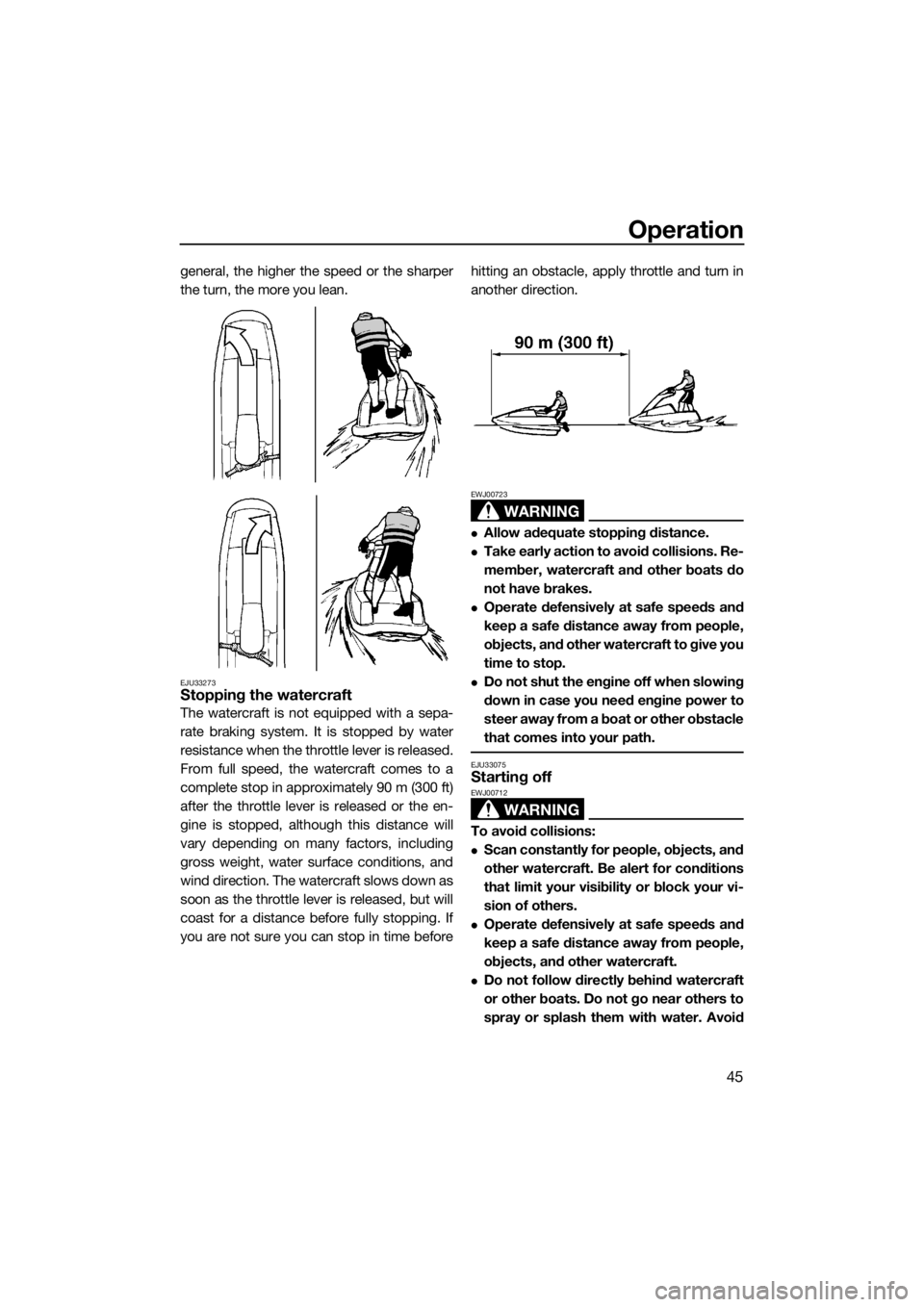
Operation
45
general, the higher the speed or the sharper
the turn, the more you lean.
EJU33273Stopping the watercraft
The watercraft is not equipped with a sepa-
rate braking system. It is stopped by water
resistance when the throttle lever is released.
From full speed, the watercraft comes to a
complete stop in approximately 90 m (300 ft)
after the throttle lever is released or the en-
gine is stopped, although this distance will
vary depending on many factors, including
gross weight, water surface conditions, and
wind direction. The watercraft slows down as
soon as the throttle lever is released, but will
coast for a distance before fully stopping. If
you are not sure you can stop in time beforehitting an obstacle, apply throttle and turn in
another direction.
WARNING
EWJ00723
Allow adequate stopping distance.
Take early action to avoid collisions. Re-
member, watercraft and other boats do
not have brakes.
Operate defensively at safe speeds and
keep a safe distance away from people,
objects, and other watercraft to give you
time to stop.
Do not shut the engine off when slowing
down in case you need engine power to
steer away from a boat or other obstacle
that comes into your path.
EJU33075Starting off
WARNING
EWJ00712
To avoid collisions:
Scan constantly for people, objects, and
other watercraft. Be alert for conditions
that limit your visibility or block your vi-
sion of others.
Operate defensively at safe speeds and
keep a safe distance away from people,
objects, and other watercraft.
Do not follow directly behind watercraft
or other boats. Do not go near others to
spray or splash them with water. Avoid
UF4D75E0.book Page 45 Monday, March 19, 2018 3:02 PM
Page 54 of 78
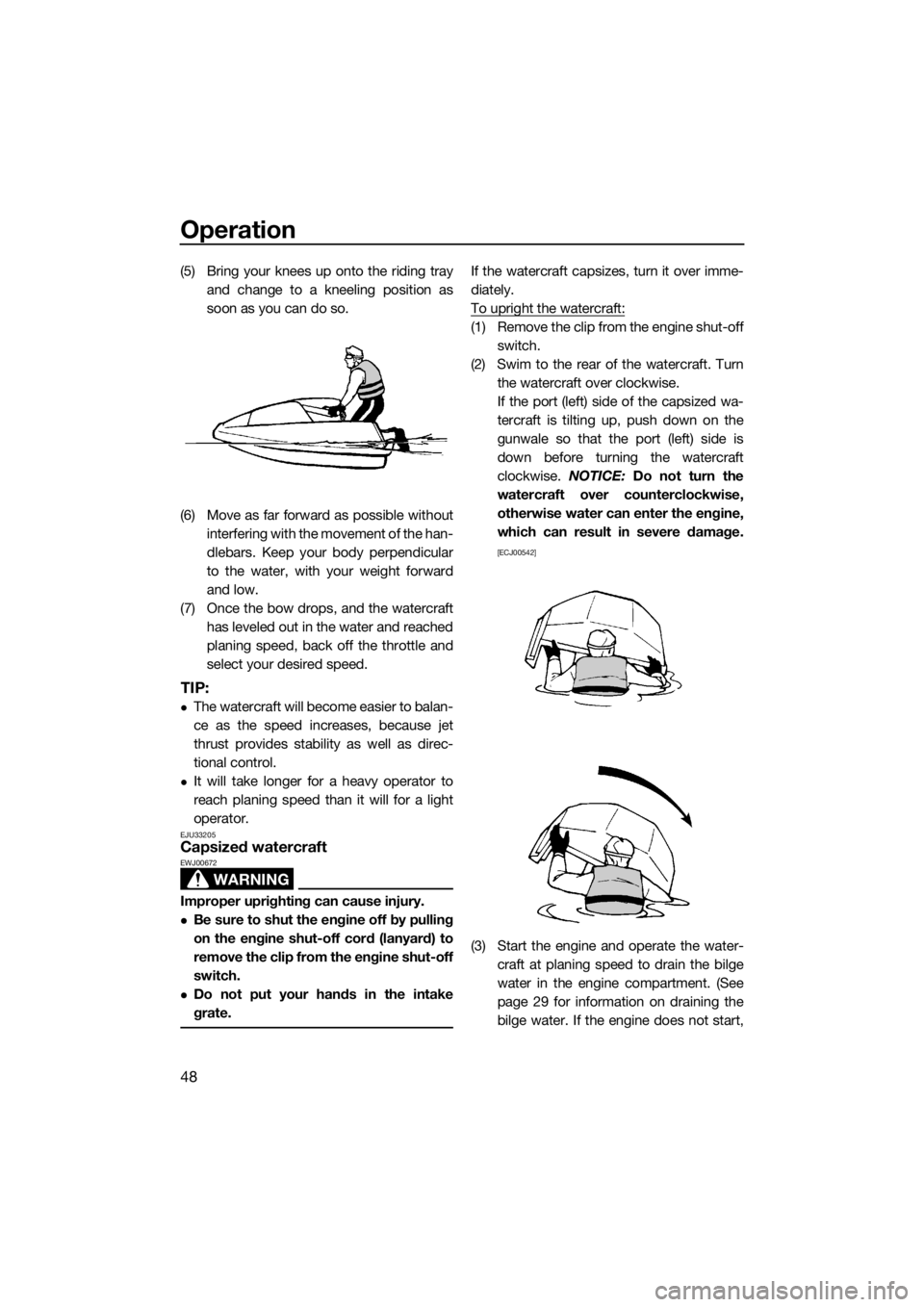
Operation
48
(5) Bring your knees up onto the riding tray
and change to a kneeling position as
soon as you can do so.
(6) Move as far forward as possible without
interfering with the movement of the han-
dlebars. Keep your body perpendicular
to the water, with your weight forward
and low.
(7) Once the bow drops, and the watercraft
has leveled out in the water and reached
planing speed, back off the throttle and
select your desired speed.
TIP:
The watercraft will become easier to balan-
ce as the speed increases, because jet
thrust provides stability as well as direc-
tional control.
It will take longer for a heavy operator to
reach planing speed than it will for a light
operator.
EJU33205Capsized watercraft
WARNING
EWJ00672
Improper uprighting can cause injury.
Be sure to shut the engine off by pulling
on the engine shut-off cord (lanyard) to
remove the clip from the engine shut-off
switch.
Do not put your hands in the intake
grate.
If the watercraft capsizes, turn it over imme-
diately.
To upright the watercraft:
(1) Remove the clip from the engine shut-off
switch.
(2) Swim to the rear of the watercraft. Turn
the watercraft over clockwise.
If the port (left) side of the capsized wa-
tercraft is tilting up, push down on the
gunwale so that the port (left) side is
down before turning the watercraft
clockwise. NOTICE: Do not turn the
watercraft over counterclockwise,
otherwise water can enter the engine,
which can result in severe damage.
[ECJ00542]
(3) Start the engine and operate the water-
craft at planing speed to drain the bilge
water in the engine compartment. (See
page 29 for information on draining the
bilge water. If the engine does not start,
UF4D75E0.book Page 48 Monday, March 19, 2018 3:02 PM
Page 62 of 78

Maintenance
56
EJU33769
Maintenance
Periodic checks and lubrication will keep
your watercraft in the safest and most effi-
cient condition possible. Therefore, make
sure to carry out the periodic maintenance.
Safety is an obligation of the watercraft own-
er. Proper maintenance must be carried out
to keep the exhaust emission and sound lev-
els within the regulated limits. The most im-
portant points of watercraft inspection and
lubrication are explained on the following pa-
ges.
See a Yamaha dealer for genuine Yamaha re-
placement parts and optional accessories
designed for your watercraft.
Remember, failures that are the result of the
installation of parts or accessories which are
not qualitatively equivalent to genuine
Yamaha parts are not covered by the limited
warranty.
Maintenance, replacement, or repair of
the emission control devices and system
may be performed by any marine SI engine
repair establishment or individual. War-
ranty repair, however, must be performed
at an authorized Yamaha marine dealer-
ship.
WARNING
EWJ00312
Be sure to turn off the engine when you
perform maintenance unless otherwise
specified. If you are not familiar with ma-
chine servicing, this work should be done
by a Yamaha dealer or other qualified me-
chanic.
EJU33803Tool kit
A tool kit is included with this watercraft. Pla-
ce the tool kit in a waterproof bag and alwayscarry it with you whenever you use the water-
craft.
EJU34338Adjusting the steering friction
The amount of friction in the steering can be
adjusted to suit operator preference.
To adjust the steering friction:
(1) Lift the steering pole and support it with
the lock pin.
1Tool bag
2Screwdriver
310/12 mm box wrench
4Garden hose adapter
5Spark plug (one included for each cylinder)
614/21 mm box wrench
7Pliers
810/12 mm open-end wrench
1Steering pole
2Lock pin
UF4D75E0.book Page 56 Monday, March 19, 2018 3:02 PM
Page 63 of 78

Maintenance
57
(2) Remove the four screws, and then re-
move the handlebar cover.
(3) Turn the handlebars so that the left han-
dlebar grip is facing down.
(4) Loosen the locknut.
(5) Tighten or loosen the adjusting nut until
the desired amount of friction is ob-
tained.
(6) While holding the adjusting nut with a
wrench, tighten the locknut to the speci-
fied torque.
(7) Securely install the handlebar cover and
four screws in their original positions.(8) While holding the steering pole, move
the lock pin to the stowed position, and
then lower the steering pole.
EJU3128AAdjusting the jet thrust nozzle angle
The angle of the jet thrust nozzle can be ad-
justed to two settings to suit operator prefer-
ence.
To adjust the jet thrust nozzle angle:
(1) Remove the two bolts, and then remove
the steering pole cover.
(2) Pull back the outer sleeve of the steering
cable joint, and then disconnect the joint
from the steering cable pivot bolt.
1Handlebar cover
1Adjusting nut
2Locknut
Tightening torque:
Locknut:
28 N·m (2.8 kgf·m, 21 lb·ft)
1
1Steering pole cover
1Steering cable joint
UF4D75E0.book Page 57 Monday, March 19, 2018 3:02 PM